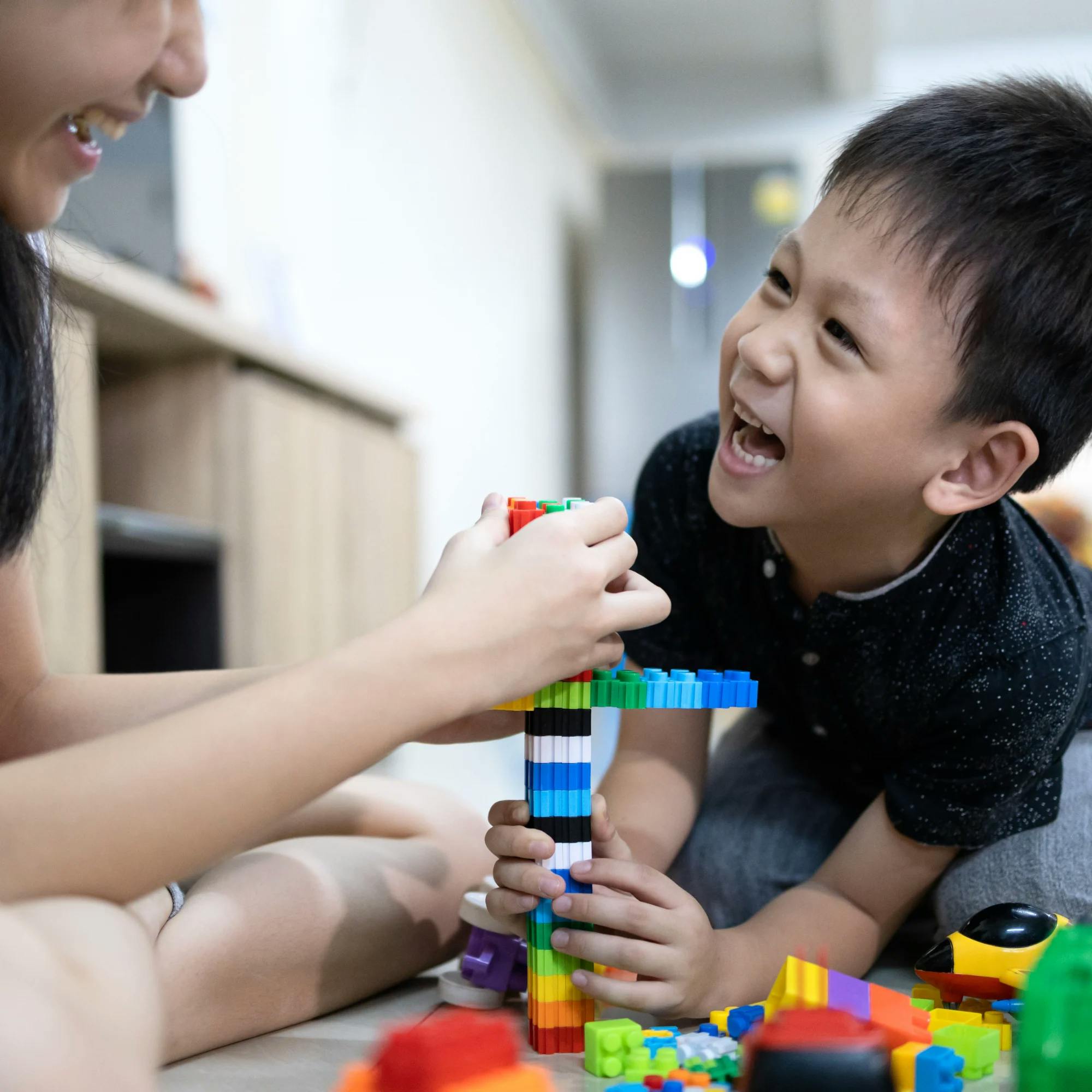
The Ultimate Guide to Childhood Apraxia of Speech: Causes, Signs, and Treatment
 Alexis Irazoque, M.S., CCC-SLP
Alexis Irazoque, M.S., CCC-SLP
At Expressable, we often hear from parents and caregivers who are trying to understand what childhood apraxia of speech is and what it means for their child. If your child doesn’t talk much, or their speech is hard to understand, you may wonder, “Does my child have apraxia? Will they outgrow it? Will my child ever talk?” These are common and important questions.
The first step is learning more about this motor speech disorder. That’s why we created this guide: to explain what speech apraxia is, the signs of apraxia in children, how apraxia is diagnosed, and how speech therapy can make a difference. With the right support and treatment, progress with verbal apraxia is always possible.
Let’s take a closer look at what apraxia of speech really means and what you can do if you’re concerned about your child’s speech.
Concerned about your child's speech?
We're here for you. Get matched with a speech therapist who's experienced in your child's area of need and available when you are.
 Find a speech therapist
Find a speech therapistWhat is childhood apraxia of speech?
When you speak, your brain sends signals to the muscles in your mouth (like the lips, jaw, and tongue) so they can move in the right way. These movements help us make sounds, form words, and speak clearly, with normal speed and rhythm.
Childhood apraxia of speech, also called CAS, speech apraxia, or verbal apraxia, is a motor-planning disorder. The word “apraxia” comes from “praxis,” which means “planned movement.” In verbal apraxia, the brain knows what it wants to say, but it has trouble sending the correct signals to the muscles needed for speech.
This means that even though a child may have the language ability to talk, their brain can’t properly plan and coordinate the mouth movements needed to say words clearly. In other words, the message gets lost somewhere between the brain and the mouth.
The brain knows what it wants to say, but it has trouble sending the correct signals to the muscles needed for speech.
As a result, children with apraxia often struggle to turn sounds into syllables, syllables into words, and words into phrases and sentences. Their speech may sound choppy, slow, or hard to understand. They’re often described as being “difficult to understand,” even when they know exactly what they want to say.
Children with apraxia are usually born with this condition (in other words, it begins in early childhood). This makes it different from acquired apraxia of speech, which happens later in life, often due to a stroke or brain injury.
What causes childhood apraxia of speech?
In many cases, the exact cause of childhood apraxia of speech is still unknown. This can feel frustrating for families, but here’s the good news: Even without a clear cause, apraxia can still be diagnosed and treated effectively.
So, what do we know about possible causes of apraxia? While research is ongoing, here are a few things experts believe may play a role:
Genetics: Apraxia can sometimes run in families. Many children with apraxia have a parent or close relative with a communication disorder or learning disability.
Neurological differences: Problems in the way the brain sends messages to the muscles used for speech may lead to speech apraxia. These issues can be caused by things like an illness, injury, or seizures.
Other conditions: Apraxia may appear in children with conditions such as cerebral palsy, autism, epilepsy, or galactosemia.
Idiopathic apraxia: In some children, there is no known cause, and no other speech or motor issues. This is called idiopathic apraxia.
No matter the cause, what’s most important is recognizing the signs of apraxia early and starting the right treatment. With proper speech therapy, children with apraxia can make great progress in learning to communicate more clearly.


Misconceptions about childhood apraxia of speech
Childhood apraxia of speech can be difficult to recognize because it’s often confused with other speech and language disorders. To really understand what apraxia is, it’s just as important to understand what apraxia is not.
Here are some common misconceptions:
“It’s just a speech delay.”
While verbal apraxia may look like a speech delay at first, it’s different. A speech delay means a child is following the usual path of speech development, just more slowly. Many children with a speech delay eventually catch up. However, children with apraxia need speech therapy to make progress. Their speech usually does not improve without treatment.
“It’s an articulation or phonological disorder.”
Some children have trouble saying certain sounds correctly. This could be an articulation disorder, where a child struggles with speech sounds like /s/ or “th.”
Others may have a phonological disorder, which involves a pattern of speech sound errors. These children may always leave off the last sound in words, or swap sounds made in the back of the mouth (like /k/ and /g/) for ones in the front (like /t/ and /d/).
In both cases, the issue is not with motor planning. It’s about learning the sounds or rules of speech, not planning the movements to say them.
“It’s dysarthria.”
Dysarthria is another motor speech disorder, but it’s caused by weakness in the muscles used for speech. Children with dysarthria may have slurred, slow, or strained speech. While some people can have both apraxia and dysarthria, they are not the same thing.
Because apraxia can look similar to other speech and language problems, it’s important to have your child evaluated by a speech-language pathologist. There’s no single test to diagnose childhood apraxia of speech. Instead, the therapist will look at a combination of signs and rule out other possibilities.
If you’re concerned about your child’s speech, early evaluation and the right kind of therapy can make a big difference.


How common is childhood apraxia of speech?
Research is lacking on the prevalence of apraxia. According to Apraxia Kids, some estimates show that childhood apraxia of speech affects about 1% of the population. Other sources show that the incidence of childhood apraxia may have increased in recent years.
Some factors that may be influencing the rise in apraxia diagnoses include:
Better awareness of childhood apraxia of speech
More research being done on apraxia
More children being evaluated for apraxia at an earlier age
What does childhood apraxia of speech look and sound like?
Every child is different, and that’s especially true for children with apraxia of speech. The symptoms of verbal apraxia can vary a lot from one child to another.
In mild cases, a child might only have trouble with a few speech sounds or with long, difficult words. In more severe cases, the child may not be able to speak clearly enough to be understood at all. Some children may only say a few words, while others may speak more but be very hard to understand.
Common signs and speech characteristics of apraxia
What does apraxia of speech sound like? Many children with apraxia share certain speech patterns. These include:
Inconsistent errors in speech: A child with apraxia might say the same word differently each time. For example, they may say a word correctly one day but struggle with it later. This inconsistency is a key feature of verbal apraxia.
Distorted sounds: Children with apraxia may not be able to move their mouth muscles into the right position. This can make their speech sound unclear. Vowel sounds are often tricky. Longer, more complex words are usually harder to say than shorter ones.
Groping for sounds: Some children appear to be “searching” for the right sounds. They may try to say a word several times before getting it right. You might notice their mouth moving around as they try to figure out how to say something.
Unusual rhythm or stress in speech: Children with apraxia may have trouble using the right stress or tone. Their speech may sound choppy or flat. They might pause at odd times or say syllables in a word with the wrong emphasis. Sometimes they leave out whole syllables or blend them together in a way that sounds unnatural.
Difficulty with voluntary speech: Many kids with apraxia can say automatic words like “hello” or “thank you,” but they have trouble when they want to say something new or start a conversation. This is because their brain has more trouble planning speech that isn't practiced or routine.
Other signs of apraxia to look for
There are other signs that might suggest a child has apraxia, especially when combined with speech difficulties:
Late talking or limited babbling in infancy
Frequent regressions, where a child stops using words they previously could say
Excessive mouth movements, often without sounds
Mixing up or leaving out sounds in words
Using the same phrases over and over, but struggling to say new things
Other challenges related to apraxia of speech
According to the Mayo Clinic, verbal apraxia often occurs alongside other developmental differences. These problems are not caused by apraxia, but they are often seen in children who have apraxia. They include:
Language delays, such as trouble understanding others, using grammar correctly, or combining words into sentences
Reading, writing, and spelling challenges, especially as children get older
Fine and gross motor coordination difficulties, such as trouble with balance, running, or using small hand movements
Sensory sensitivities, like avoiding certain food textures, disliking the feel of clothing, or avoiding toothbrushing
If you're noticing any of these signs, it’s important to talk to a speech therapist. They can help determine whether your child has apraxia or another speech or language disorder, and create a treatment plan that meets your child’s needs.
Is apraxia of speech a disability?
Apraxia is not a disability, but as explained above, it often comes with communication challenges. Children with apraxia may need special support in school. Some people with apraxia may communicate in ways other than speaking, such as by using an AAC device. Learn more about what kinds of support children with verbal apraxia might need here.


Will my child with apraxia be able to talk?
Many children with childhood apraxia of speech can learn to talk with the help of regular, personalized speech therapy. Some children go on to speak clearly and confidently. Others may still have some small differences in how they speak. Their speech sounds may be less crisp, or they may have differences in how their voice rises and falls. In rare cases, a child may need to use other ways to communicate, such as pictures or devices, for the long term.
Every child is different. Progress depends on things like how severe the apraxia is, whether the child has other conditions like autism, how early speech therapy begins, and how often they receive therapy.
While no one can say exactly what your child’s outcome will be, there is a lot of hope. With the right support, children with apraxia can make big progress. They can grow up to lead happy, successful lives.


How is childhood apraxia of speech diagnosed?
A speech therapist is the most qualified professional to diagnose and treat childhood apraxia of speech. The process usually begins with a comprehensive evaluation.
Diagnosing apraxia can be tricky. There is no single test or symptom that confirms the diagnosis. Instead, your child’s speech therapist will look for a pattern of signs and symptoms, while also ruling out other conditions that might cause similar difficulties, such as a general speech delay.
What does an evaluation for apraxia include?
Your child’s speech therapist will carefully look at many areas of communication and development, including:
Speech sound production: The therapist will examine how your child says words and sounds. A key sign of apraxia is inconsistent errors (for example, your child may say the same word differently each time).
Repetition of words: The therapist may ask your child to repeat words several times or say longer and longer words. This helps identify signs like groping, sound distortion, or difficulty with complex words.
Expressive language: This refers to how your child uses words, phrases, and gestures to express their thoughts. Children with apraxia often have delayed expressive language skills because they struggle to form words and sentences clearly.
Receptive language: This is your child’s ability to understand language–what people say to them or what they read. Some children with apraxia have age-appropriate understanding, even if they have trouble speaking. Others may show delays in both expressive and receptive language skills.
Medical and developmental history: The therapist will ask about your child’s milestones, family history, and how your child communicates at home and in other settings.
In some cases, your speech therapist may also give an articulation or speech sound test to check how consistent or inconsistent your child’s errors are. This helps confirm whether the speech difficulty fits with apraxia.
Why is an accurate diagnosis of apraxia important?
Because verbal apraxia is a complex motor speech disorder, getting the right diagnosis early helps your child receive appropriate therapy and support. Children with apraxia need frequent, individualized therapy that focuses on improving how the brain plans and coordinates the movements needed for clear speech.
How is childhood apraxia of speech treated?
Children with apraxia will not outgrow it on their own. They won’t learn the basics of speech just by being around other children. They need to receive the right kind of support early and often.
At Expressable, once your speech therapist understands your child’s communication abilities, they’ll develop a personalized treatment plan just for them. Childhood apraxia of speech often requires frequent, one-on-one speech-language therapy. These sessions are usually intensive, with lots of repetition and personal attention. Treatment for apraxia of speech may last several months or years, depending on your child’s progress and needs.
Speech therapy for apraxia is especially important because it helps your child learn how to clearly express their thoughts, needs, and feelings. This can improve their confidence, social interactions, school performance, and overall quality of life.
Many children with apraxia benefit from:
Repeating sounds, words, and phrases multiple times
Practicing small sets of meaningful words they use daily
Saying words at the same time as their therapist or caregiver
Being shown how to move their mouth to form sounds correctly
Using multisensory cues, like hand signs or visual models, to support accurate speech
At Expressable, speech therapy for apraxia is based on the principles of motor learning. That means children practice the same sound patterns many times until they can say them clearly and consistently, even in everyday conversation. This repetition helps “train the brain” to make speech more automatic.
As your child improves, their therapist will gradually increase the complexity of the words and sentences they practice. The goal is to help your child use new words spontaneously and independently.
In more severe cases, children may also need alternative or augmentative communication (AAC) tools to support their speech. These can include:
Sign language
Picture boards or notebooks
AAC devices such as speech-generating tablets
These tools help reduce frustration and build confidence while your child continues to develop their verbal skills in therapy. Often, they’re used temporarily, but they can make a big difference in helping your child communicate with others in the meantime.
Every child with apraxia is unique, so treatment will look different for everyone. That’s why one of the most important things you can do as a caregiver or parent is to offer encouragement and practice therapy techniques at home.
How does Expressable online speech therapy work for apraxia of speech?
At Expressable, we offer a specialized program for childhood apraxia of speech that’s grounded in the latest research and designed by clinical experts. Our mission is simple: to help your child speak more clearly and confidently.
Once you’re matched with a licensed speech-language pathologist trained in apraxia, your child will receive a thorough evaluation, as described above. Based on the results, your therapist will create a personalized care plan focused on your child’s needs. This typically includes two speech therapy sessions per week and regular check-ins to adjust goals as your child progresses. You can also text your speech therapist throughout the week with questions or concerns.
Expressable speech therapists follow proven strategies to treat childhood apraxia of speech, as described in the section above. Parent coaching is also a key part of speech therapy at Expressable. Here’s how online speech therapy works based on your child’s age:
Ages 0-3: Parents or caregivers attend sessions and work directly with the speech therapist to learn how to practice speech strategies at home, during daily routines.
Ages 3-6: Caregivers continue to attend and learn alongside their child. Practicing with your child outside the session will continue to promote skill-building. With apraxia, repetition helps your child’s brain and mouth work together more smoothly.
Ages 7 and up: Many children attend sessions on their own, but parents are kept informed with tips, updates, and practice activities.
Get matched with a speech therapist who's right for you
Get started nowSupport beyond sessions: The Expressable portal
To support learning all week long, Expressable offers a client portal filled with helpful resources. You'll find:
Learning Paths that explain therapy strategies in simple terms
Demo videos showing how to practice speech techniques at home (like multisensory cueing and imitation)
Weekly home practice activities tailored to your child’s therapy plan
Quizzes and examples to reinforce understanding
Text messaging with your therapist for ongoing support and guidance
At Expressable, we know that learning doesn’t stop when the therapy session ends. That’s why we help you integrate speech therapy into your daily life, whether at the dinner table, during playtime, or while getting ready for bed. The more practice your child gets, the faster they’ll improve.
Every therapy journey is different, and your speech therapist will work with you to make sure apraxia treatment is effective, functional, and tailored to your child’s communication needs. Our goal is for your child to use their speech skills confidently across all areas of life, from home to school to friendships.

Tips to help parents support their child with apraxia
One of the most powerful tools children with apraxia have is their family. Many studies show that parents play a key role in helping their child make progress with speech and language. That’s because caregivers spend the most time with their child and can turn everyday moments into meaningful opportunities to practice communication.
Even though apraxia can be challenging, there are simple ways to support your child throughout the day. Your speech therapist should give you strategies you can use at home. They’ll show you how to help your child feel supported, understood, and proud of their effort, no matter what stage they’re in.
Here are some helpful tips for helping a child with apraxia at home:
Let your child know their voice matters. Even if it’s hard to understand their words, show your child that their thoughts and needs are important. Pay attention to their facial expressions, gestures, and the situation for clues. When you figure out what they’re saying, tell them! For example, “Oh! You’re pointing at the fridge…you must be hungry.”
Give them time and space to speak. Try not to pressure your child to talk, especially if they seem tired, frustrated, or unsure. When they do try to speak, be patient. Allow plenty of time for them to get their message out.
Even if it’s hard to understand their words, show your child that their thoughts and needs are important.
Use positive reinforcement. Encouragement goes a long way. Try saying things like, “You’re working so hard. I’m proud of you!” This helps your child feel supported, even when speaking is difficult.
Help them feel seen and comforted. If your child seems upset or discouraged, offer comfort. A hug, kind words, or even a smile can show that you understand how they’re feeling.
Establish a topic. Make it clear what you’re talking about, like “What do you want for dinner?” This can make it easier for both of you to stay on the same page.
Ask simple questions. If you’re not sure what your child is trying to say, use yes-or-no questions to narrow it down. Focus on understanding the main idea rather than every word.


Get started with Expressable
If you’re concerned about your child’s speech, contact Expressable today. Get matched with a speech therapist who's experienced in your child's area of need and available when you are. Start our simple sign-up here!
How Expressable Can Help
Concerned your child isn't reaching age-expected milestones? Looking for communication support from a professional? Expressable is a national online speech therapy practice serving children and adults. We treat all major areas of communication and feeding, offer flexible hours including evenings and weekends, and accept most major health insurance plans. We’re proud to have earned more than 3,000 5-star reviews from our clients (4.9/5 average).
Our therapy model is centered on parent and caregiver involvement. Research proves that empowering caregivers to participate in their loved one’s therapy leads to better outcomes. That’s why we combine live, 1-on-1 speech therapy with personalized education and home practice activities for faster progress.
Communication is more than words. It’s how we share how we feel and show who we are. We’re here to help you or your child do just that.










